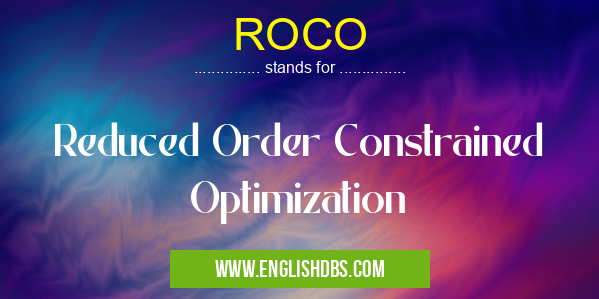What does ROCO mean in UNCLASSIFIED
Reduced Order Constrained Optimization (ROCO) is a technique used in engineering and other fields to solve complex optimization problems with constraints. It involves reducing the order, or complexity, of the optimization problem while still maintaining its essential characteristics. This allows for more efficient and faster computation, especially in situations with a large number of design variables or constraints.

ROCO meaning in Unclassified in Miscellaneous
ROCO mostly used in an acronym Unclassified in Category Miscellaneous that means Reduced Order Constrained Optimization
Shorthand: ROCO,
Full Form: Reduced Order Constrained Optimization
For more information of "Reduced Order Constrained Optimization", see the section below.
Introduction: Reduced Order Constrained Optimization (ROCO)
How ROCO Works
- Problem Definition: The initial optimization problem is defined, including the objective function to be minimized or maximized and the constraints that must be met.
- Reduced Order Model: A reduced order model of the original optimization problem is created. This simplified model captures the most important features of the original problem while having a lower computational cost.
- Surrogate Model: A surrogate model, or approximation, of the original objective function and constraints is developed based on the reduced order model. This surrogate model is typically much faster to evaluate than the original functions.
- Optimization: The reduced order optimization problem is solved using the surrogate model. This involves finding the optimal solution that satisfies the constraints within the simplified model.
- Solution Improvement: The optimal solution from the reduced order problem is then used as an initial guess for solving the original optimization problem. This helps to refine the solution and obtain a better result.
Advantages of ROCO
- Computational Efficiency: ROCO significantly reduces computational time compared to solving the original optimization problem directly.
- Scalability: It can handle large-scale problems with a vast number of design variables and constraints.
- Robustness: ROCO provides robust solutions even when the original optimization problem is nonlinear or has multiple local optima.
Essential Questions and Answers on Reduced Order Constrained Optimization in "MISCELLANEOUS»UNFILED"
What is Reduced Order Constrained Optimization (ROCO)?
ROCO is a technique used to solve complex optimization problems with constraints by reducing the problem's dimensionality. It involves approximating the original problem with a simplified, smaller-scale problem that retains the essential characteristics of the original.
How does ROCO work?
ROCO employs projection techniques to create a reduced-order model that captures the dominant features of the original problem. This reduced-order model is then used to iteratively update the solution of the original problem, ensuring that the constraints are satisfied.
What are the advantages of using ROCO?
ROCO offers several advantages:
- Reduced computational cost: By working with a smaller-scale problem, ROCO significantly reduces the computational complexity.
- Faster convergence: The reduced-order model allows for faster convergence to an optimal solution.
- Improved accuracy: ROCO incorporates sophisticated projection techniques to ensure the reduced-order model accurately represents the original problem.
What types of problems can be solved using ROCO?
ROCO is applicable to a wide range of constrained optimization problems, including:
- Structural optimization
- Fluid dynamics optimization
- Control system design
- Chemical process optimization
What software tools are available for ROCO?
Several software tools support ROCO, including:
- MATLAB Optimization Toolbox
- ANSYS Workbench
- COMSOL Multiphysics
What are the limitations of ROCO?
While ROCO offers significant advantages, it has some limitations:
- Approximation errors: The reduced-order model may introduce approximation errors that can affect the accuracy of the solution.
- Applicability to specific problems: ROCO is most effective for problems with certain structural properties.
Final Words: ROCO is a powerful technique for solving complex optimization problems with constraints. It offers significant advantages in terms of computational efficiency, scalability, and robustness. By reducing the order of the problem while retaining its important characteristics, ROCO enables engineers and researchers to solve problems that would otherwise be impractical or time-consuming to solve using conventional methods.
